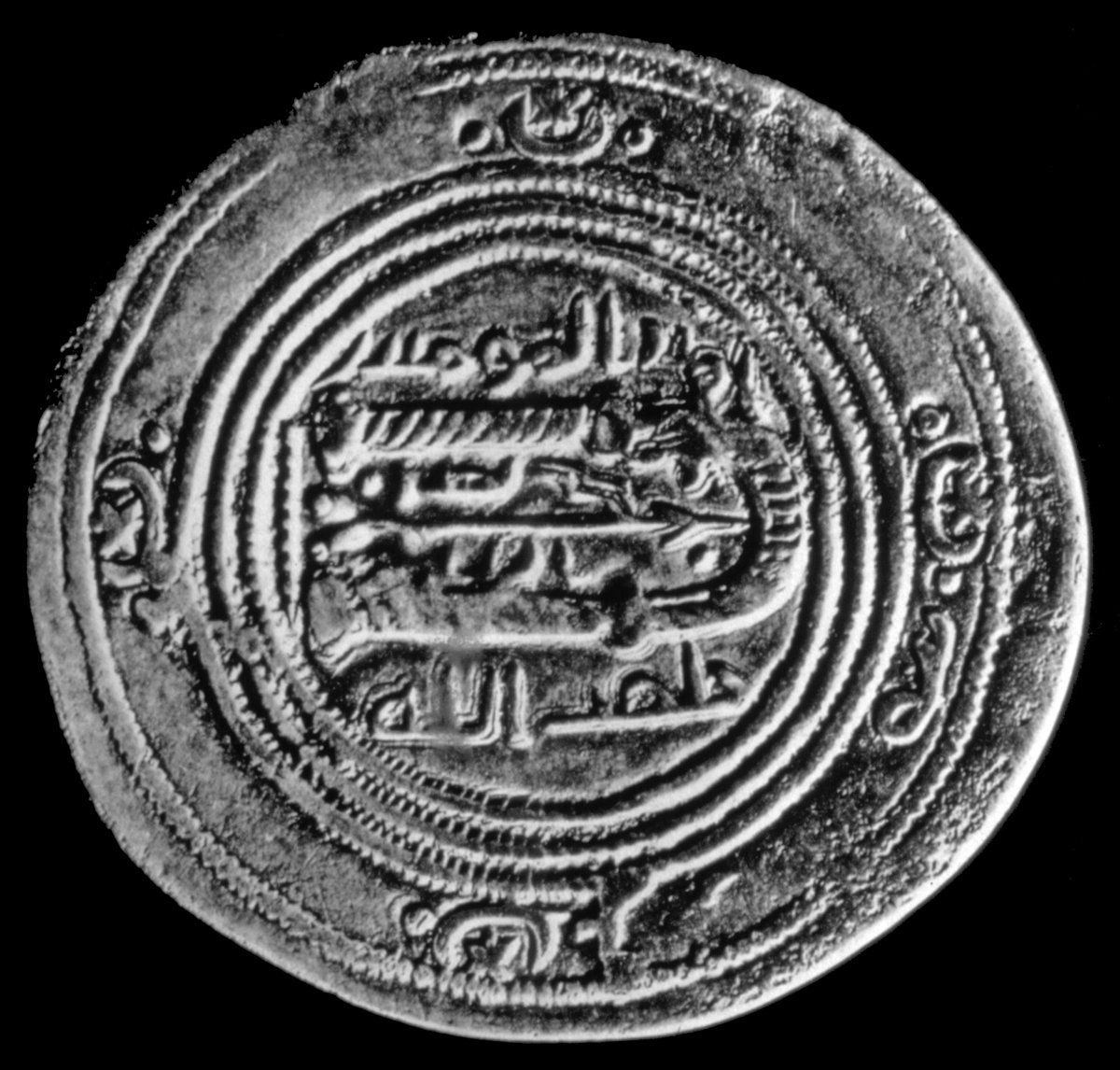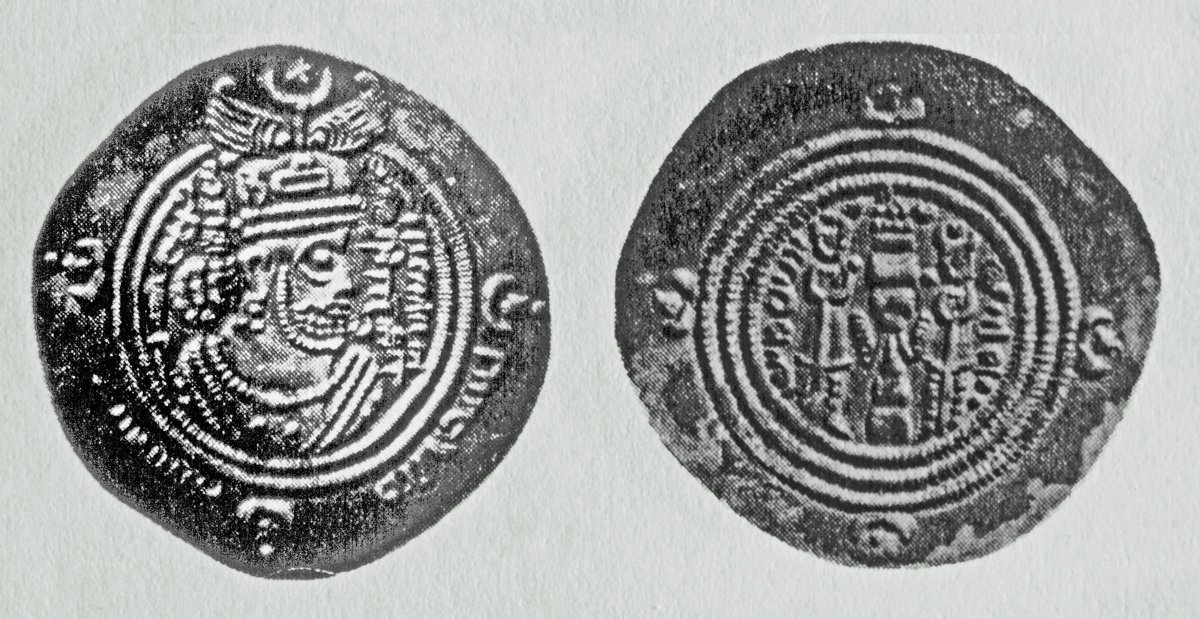
Dirham – Islamic World Silver Coin
The Arabs of the Hejaz, who did not have their own money, used the Byzantine gold dinar and silver dirhams of Iran and Yemen, Khalil Sahillioglu writes for İslam Ansiklopedisi.
The word “dirhem” comes from “drachma” – the name of the ancient Greek currency. It was borrowed by the Arabs through Iran and is mentioned in the Qur’an (Surah Yusuf, 12/20). The Arabs used the Sassanian dirhams before the conquest of Iraq and Iran without any modification. According to al-Maqrizi, during the time of Umar (may Allah be pleased with him), they began to mint Iranian dirhams. They weighed 2.97 grams. On the obverse of the Sassanian dirhams were placed the image of the rulers, and on the reverse – the temple of fire, guarded by two guards. On these coinsin the Pahlavi language, the symbol or the full name of the place of minting was indicated, as well as the year of minting, counting from the accession to the throne of one or another ruler. The drawing occupied the central part of the coin, and rather wide fields remained on the edge, on which the image of four crescents with stars was applied.
Over time, more Islamic elements appeared on the Sassanian dirhams, minted by the caliphs. Islamic phrases appeared on them, such as “Bismillah” (“In the name of Allah”), “Bismillahi Rabbi” (“In the name of Your name, O Lord”), ” Jayyid“(” Good “) and” words of testimony. ” The date of minting began to be indicated in accordance with the Hijri calendar, but the place of minting was still indicated for some time in pahlavi. The names of the rulers were also written sometimes in Pahlavi, sometimes in Arabic. As happened with the dinar, over time, the non-Islamic elements on the dirham disappeared. Instead of a temple of fire, they began to depict a mihrab with a spear in the middle, to the left of it the inscription “amir al-muminin” (“ruler of the faithful”), to the right – “khalifatullah” (“viceroy of Allah”), to the left of the spear, inside the mihrab, they wrote “nasr” (“Victory”), and on the right is “Allah”. On the obverse, the Persian rulers were replaced by a caliph with a sword, and then simply by an inscription in Arabic. Thus, an exclusively Islamic version of the dirham appeared – without images, with inscriptions in Kufic script, differing in shape and weight from the Sassanid coin.

Sassanian dirham with Kufic inscriptions / Source: İslam Ansiklopedisi
Although the Umayyad and Abbasid caliphs up until al-Mamun did not mint dinars in their honor, some of them put their names on dirhams. According to numismatics, in the Umayyad state during its existence from 698 to 750 years. there were 70 mints.
The weight of the dirhams of Shah Khosrov II ranges from 4.11-4.15 g. The Sassanid dirhams issued by the Arabs were lighter, they weighed 3.95 g. Since the weight of the dirhams of Tabaristan is 1.80-1.95 g., One can assume that is half dirhams. The weight of the dirhams minted at other mints is very different, and among the Sassanian-Arab ones it was not at all stable.
Although the dirham went through several critical periods, it, like the dinar, soon became an international currency. Muslims paid them for silk from China, furs, slaves, wax and leather coming from the territory of modern Russia. Dirhams are found along rivers in the European part of Russia, in the Gulf of Finland in the region of lakes near Stockholm, on the island of Gotland in the Baltic Sea, in the treasures of Denmark, France and in the north of England. Most of them come from Maverannahr – these are Samanid, Gaznevid, Karakhanid coins… Although there are Sassanian and Arab-Sassanian ones. Their great honor was minted until the beginning of the 12th century. The absence of dirhams of a later period indicates that their influx into the territory of modern Russia has stopped. Some historians associate this with the campaign of Prince Svyatoslav in the Caspian Sea, while others – with the lack of silver in the Islamic world. This shortage became apparent in the X-XII centuries, affecting the Maghreb as well. It was during these centuries that the Islamic world began to lose its political integrity. The circulation of dirhams decreased or disappeared altogether, they were replaced by other coins, such as copper money (fulus) and the “black dirhem” or “dirhem nukre”, which consisted of two-thirds of copper.

Umayyad dirham of the time of Abdul-Malik ibn Marwan / Source: İslam Ansiklopedisi
Islamic dirhams entered Europe through Spain as payment for weapons, timber, and slaves. In Europe they were called “mankush”. Charlemagne pursued a policy of pegging money to the dirham. Gold, which entered Europe through the Mediterranean Sea, allowed in the XII century. Europe to mint gold coins again and return to bimetallism. Simultaneously, the circulation of silver dirhams increased again in North Africa, Egypt and Syria.
The Crusaders minted imitations of Islamic money, including dirhams, using silver that came from Europe. Their gold coin was a copy of the Fatimid gold coin, and their dirhams were the Ayyubid dirhams. At first, Islamic inscriptions were preserved on them unchanged, but over time they were replaced by phrases of Christian content, but in Arabic. At some point, the Byzantine Empire was also under the influence of Arab dirhams , and in the VIII-IX centuries. emperors minted silver coins under the name “miliary”. In Europe, in particular in southern France and Italy, dirhams were minted on the model of the coins of the Almohads from North Africa. Such coins, called millarrès, at one time filled the bazaars of the Maghreb.
Dirham today is the name given to the monetary units of countries such as the United Arab Emirates and Morocco. Also the name of the dirham is one thousandth of the Libyan dinar, one hundredth of the rial of Saudi Arabia and one-tenth of the dinar of Kuwait.

Umayyad dirham minted in Armenia in 717-718 / Source: İslam Ansiklopedisi
Islamosphere

